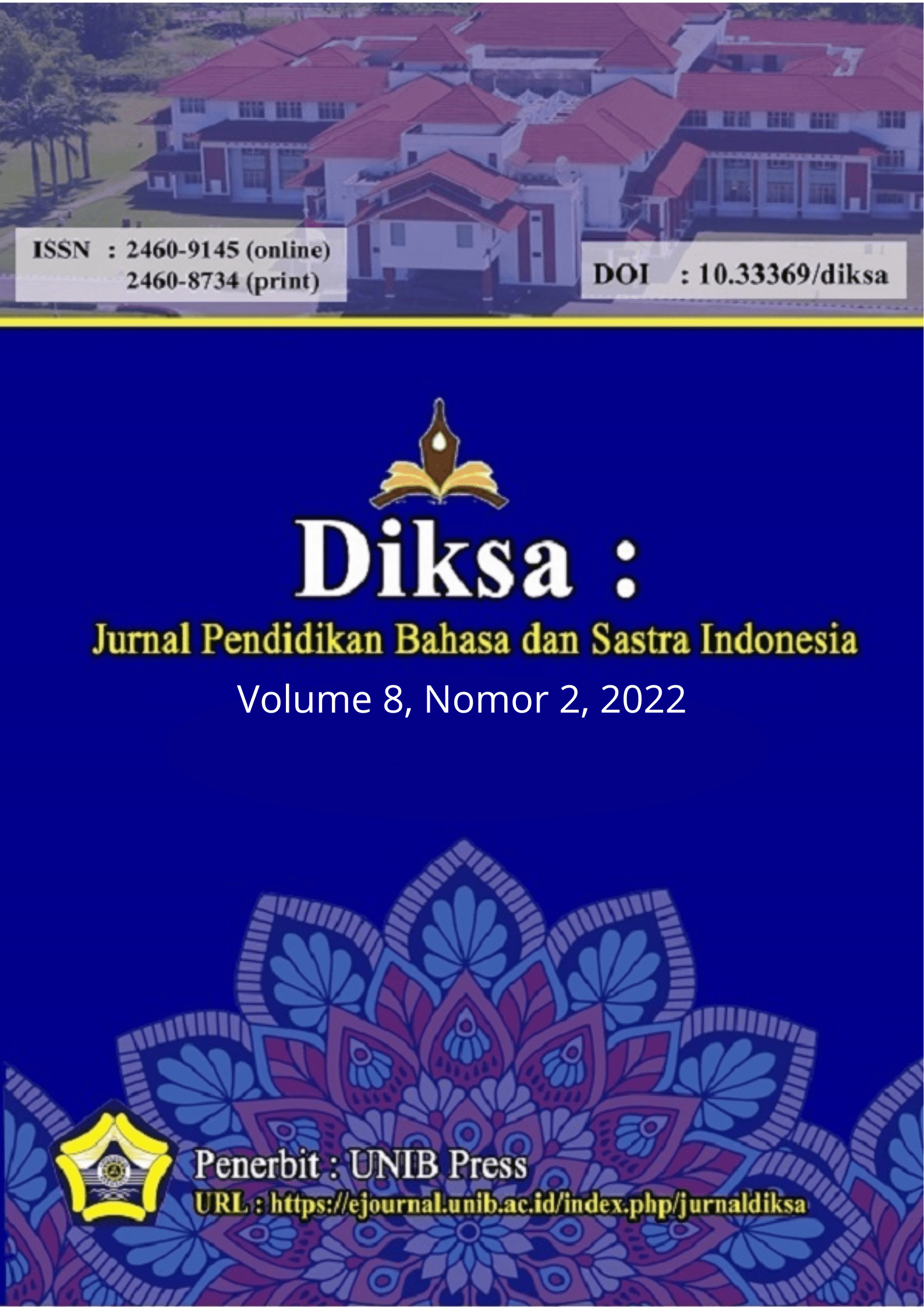Main Article Content
Abstract
Development of Reader Response-Based Archipelago Folklore Teaching Materials aims to increase students' intellectual activity through archipelago folklore. data, (3) product design, (4) design validation, (5) design improvement, (6) product trial (7) design improvement. Data analysis uses qualitative data analysis techniques, while the validation sheet analysis and questionnaire steps include: converting quantitative data into qualitative, tabulating the data obtained on each aspect, calculating the average score, and changing the average score into categories. Research results shows that 1) the need for teaching materials according to teachers and students, paying attention to: (a) the context of language for various purposes, (b) keeping up with the times, (c) in accordance with the applicable curriculum by raising themes around students, ( d) the relevance between teachers and students in teaching (f) tasks/practices can activate students, (g) material attracts students' interest, is clear, and easy to understand, and (h) relatively 2) describes the teacher's role in learning appreciation of archipelago folklore through reader response model, obtain an overview of student activity in dealing with Indonesian folklore through the reader response model, 3) Product quality based on The results of the validation of material experts based on the percentage of assessment scores obtained an average score of 93.75%, media expert validation of the percentage of assessment scores obtained an average score of 81.66%, 3 educator assessments obtained an average score of 88.59%. Based on the results of the overall validation with an average score that is categorized as very feasible to use.
Keywords
Article Details
Copyright (c) 2023 DESI ANGGRAINI

This work is licensed under a Creative Commons Attribution-ShareAlike 4.0 International License.
Authors who publish with this journal agree to the following terms:
- Authors retain copyright and grant the journal right of first publication with the work simultaneously licensed under a Creative Commons Attribution License that allows others to share the work with an acknowledgment of the work's authorship and initial publication in this journal.
- Authors are able to enter into separate, additional contractual arrangements for the non-exclusive distribution of the journal's published version of the work (e.g., post it to an institutional repository or publish it in a book), with an acknowledgment of its initial publication in this journal.
- Authors are permitted and encouraged to post their work online (e.g., in institutional repositories or on their website) prior to and during the submission process, as it can lead to productive exchanges, as well as earlier and greater citation of published work (See The Effect of Open Access).
References
- Prastowo Andi, 2015. Panduan Kreatif Membut Bahan Ajar Inovatif.Jogjakarta: Diva Press.
- Arsyad Azhar, 2017. Media Pembelajaran. Jakarta: PT RAJAGRAFINDO PERSADA.
- Dananjaya James, 1994. Foklor Indonesia. Jakarta: Pustaka Utama Grafiti.
- Spirovska, E. (2019). Reader-Response Theory and Approach: Application,
- Kusinwati, 2009. Mengenal Karya Sastra Indonesia. Semarang, Jawa Tengah: ALPRIN.
- Giangiulio Lobo, A. (2013). Reader-Response Theory: A Path Towards Wolfgang Iser. Letras, 1(54), 13–30. https://doi.org/10.15359/rl.2-54.1.
- Tarigan Henry Guntur, 2008. Membaca Sebagai Suatu Keterampilan Berbahasa.Bandung:Angkasa
- Mahendra I Wayan Eka, Ni Nyoman Parmithi. 2015. Statistik Dasar Dalam Penelitian Pendidikan. Surabaya: PÀRAMIT
- Yusuf, Muri, 2017. Metode Penelitian Kuantitatif, Kualitatif dan Penelitian Gabungan, Jakarta: Kencana.
- Hani Yuli Nanda, Wasis Himawanto,2017. Statistik Pendidikan. Yogyakarta: Budi Utama.
- Nurdyansyah,2019. Media Pembelajaran Inovatif. Jawa Timur: UMISDA Press.
- Risdawati, 2017. Perkembangan Sejarah Sastra Indonesia.Banda Ace: Bina Karya Akademika
- Gani,Rizal, 1988. Pengajaran Sastra Indonesia Respons dan Analisis, Padang: P2LPTK.
- Kundharu,Saddhono,St,Y Slamet, 2012. Meningkatkan Keterampilan Berbahasa Indonesia. Bandung:Karya Putra Darwati
- Samsu, 2017. Metode Penelitian Teori dan Aplikasi Penelitian Kualitatif, Kuantitatif,
- Mixed Methods, serta Research & Development. Jambi: PUSAKA
- Sugiono, 2013. Metode Penelitian Kuantitatif,Kualitatif dan R&D. Bandung: Alfabeta.
- Sugiono, 2015. Metode Penelitian Pendidikan. Bandung: Alfabeta
- Sugiono. 2017. Metode Penelitian Kuantitatif,Kualitatif dan R&D. Bandung: Alfabeta.
- Sugiono, 2017. Statistik Untuk Penelitian. Bandung: Alfabeta.
- Samsu, 2017. Metode Penelitian Teori dan Aplikasi Penelitian Kualitatif, Kuantitatif,
- Mixed Methods, serta Research & Development. Jambi: PUSAKA
- Santoso Puji, Djamuri, 2014. Apresiasi Sastra. Yogyakarta: Ematera.
- Shoffa Shoffan dkk, 2021. Perkembangan Media Pembelajaran Di Perguruan Tinggi. Bojonegoro Jawa Timur: AGRAPANA MEDIA.
- Mart, C. T. (2019). Reader-response theory and literature discussions: A springboard for exploring literary texts. New Educational Review, 56(2), 78–87. https://doi.org/10.15804/tner.2019.56.2.06.
References
Prastowo Andi, 2015. Panduan Kreatif Membut Bahan Ajar Inovatif.Jogjakarta: Diva Press.
Arsyad Azhar, 2017. Media Pembelajaran. Jakarta: PT RAJAGRAFINDO PERSADA.
Dananjaya James, 1994. Foklor Indonesia. Jakarta: Pustaka Utama Grafiti.
Spirovska, E. (2019). Reader-Response Theory and Approach: Application,
Kusinwati, 2009. Mengenal Karya Sastra Indonesia. Semarang, Jawa Tengah: ALPRIN.
Giangiulio Lobo, A. (2013). Reader-Response Theory: A Path Towards Wolfgang Iser. Letras, 1(54), 13–30. https://doi.org/10.15359/rl.2-54.1.
Tarigan Henry Guntur, 2008. Membaca Sebagai Suatu Keterampilan Berbahasa.Bandung:Angkasa
Mahendra I Wayan Eka, Ni Nyoman Parmithi. 2015. Statistik Dasar Dalam Penelitian Pendidikan. Surabaya: PÀRAMIT
Yusuf, Muri, 2017. Metode Penelitian Kuantitatif, Kualitatif dan Penelitian Gabungan, Jakarta: Kencana.
Hani Yuli Nanda, Wasis Himawanto,2017. Statistik Pendidikan. Yogyakarta: Budi Utama.
Nurdyansyah,2019. Media Pembelajaran Inovatif. Jawa Timur: UMISDA Press.
Risdawati, 2017. Perkembangan Sejarah Sastra Indonesia.Banda Ace: Bina Karya Akademika
Gani,Rizal, 1988. Pengajaran Sastra Indonesia Respons dan Analisis, Padang: P2LPTK.
Kundharu,Saddhono,St,Y Slamet, 2012. Meningkatkan Keterampilan Berbahasa Indonesia. Bandung:Karya Putra Darwati
Samsu, 2017. Metode Penelitian Teori dan Aplikasi Penelitian Kualitatif, Kuantitatif,
Mixed Methods, serta Research & Development. Jambi: PUSAKA
Sugiono, 2013. Metode Penelitian Kuantitatif,Kualitatif dan R&D. Bandung: Alfabeta.
Sugiono, 2015. Metode Penelitian Pendidikan. Bandung: Alfabeta
Sugiono. 2017. Metode Penelitian Kuantitatif,Kualitatif dan R&D. Bandung: Alfabeta.
Sugiono, 2017. Statistik Untuk Penelitian. Bandung: Alfabeta.
Samsu, 2017. Metode Penelitian Teori dan Aplikasi Penelitian Kualitatif, Kuantitatif,
Mixed Methods, serta Research & Development. Jambi: PUSAKA
Santoso Puji, Djamuri, 2014. Apresiasi Sastra. Yogyakarta: Ematera.
Shoffa Shoffan dkk, 2021. Perkembangan Media Pembelajaran Di Perguruan Tinggi. Bojonegoro Jawa Timur: AGRAPANA MEDIA.
Mart, C. T. (2019). Reader-response theory and literature discussions: A springboard for exploring literary texts. New Educational Review, 56(2), 78–87. https://doi.org/10.15804/tner.2019.56.2.06.
